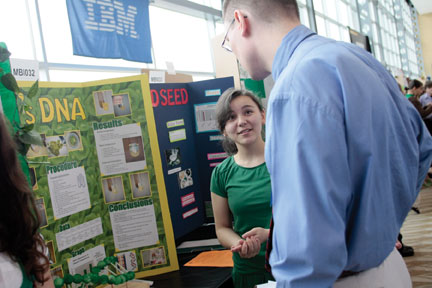 Spring 2009
Spring 2009|
“ Look around your world and fix a problem. It’s that simple.” – Science Fair participant Lauren Sendek |
With its sensor “eyes” and LED “grin,” Jonathan Dumm’s robot possesses all of the charm of Pixar’s animated film WALL-E. Only Dumm’s machine isn’t a cartoon fantasy; it’s the real deal. The high school senior built his robot in his Penn Hills garage, working for months to solve the problem of autonomous navigation. That is, how do you create a robot that can move safely on its own and, when it senses danger, override human control to avoid a collision? Dumm’s shoebox-sized robot on wheels uses the principles of logic to do just that. It is a goal that computer scientists and engineers have been trying for years to achieve on a grander scale. So the 18-year-old’s accomplishment didn’t go unnoticed. His robot took a top award last year at the Pittsburgh Regional Science and Engineering Fair organized annually by Carnegie Science Center—just one example of the competition’s rich and storied tradition of scientific excellence among middle and high school students. A Pittsburgh institution since 1939, the Science Fair will mark its 70th anniversary this April, making it one of the oldest continuously running events of its kind in the country. The Science Center is inviting past participants to return to the fair this spring to celebrate this historic occasion and share stories about how the competition has helped inspire generations of budding young scientists. Ron Baillie, The Henry Buhl, Jr. Co-Director of Carnegie Science Center, remembers hopping a bus to the North Side with his childhood friends to view the projects on display at the former Buhl Planetarium and Institute for Popular Science. “The fair was part of the original vision for the planetarium,” Baillie recalls. “They would remove all of the exhibits and literally fill the whole building with science fair projects. It was always exciting.” Interest in the Science Fair remained high until the end of the last century, Baillie notes, tending to spike after major events in science history such as the lunar landing. But by the late 1990s, participation had waned to an all-time low. The outdated competition needed a “new look and feel and energy” to stand out among the countless extracurricular activities vying for students’ attention. Call it Extreme Makeover, Science Fair edition. Fair participants are now guaranteed one-on-one time with the judges to get direct feedback about their projects. And among the prizes: college scholarships, which students receive at a ceremony held the second day of the event. Fittingly, competition now takes place in the Club Levels of Heinz Field. “We are honoring our young scientists in the same venue where we honor the sports heroes that are so important to this city,” says Mike Hennessy, program production coordinator at the Science Center, who took first place in the biology category at the Science Fair in 1995. “I think that sends a really powerful message.” Hennessy credits the competition with sparking his own interest in science education. The fair’s message about the power of hard work and the value of education is obviously resonating with students again. In 2008, there were a record-high 1,004 entrants in the competition, hailing from 105 schools in 12 counties. They competed for more than $750,000 in cash prizes, scholarships, and trips made possible through sponsorship from scores of corporations, foundations, and universities, not to mention the effort of hundreds of volunteer judges. “The community is recognizing the need to nurture young scientists and engineers and encourage them to stay here for college and beyond,” says Science Fair director Lisa Kosick. “This is our future workforce.” A quick glance at last year’s project titles shows the promise embodied by these students. Gone is the era of baking soda volcanoes and scale models of the solar system. Fueled by intellectual curiosity, access to cutting-edge technology, and a competitive spirit, Science Fair entrants today are probing the human genome and studying the evolution of faraway galaxies. In 2000, four-time Science Fair participant Lauren Sendek won “best in show” and several international awards for developing a computer program that implemented a genetic algorithm to expedite drug discovery. Now an instructional technologist at the University of Pittsburgh, Sendek recently used her prize money to help make a down payment on her house and returns to the Science Fair each year as a judge. She maintains it’s the originality—not the complexity—of the project that matters most. “Look around your world and fix a problem,” Sendek says. “It’s that simple.” Win or lose, though, all Science Fair participants take away invaluable lessons in how to design a research project, follow it through to the end, and communicate their findings. The next aim is to engage even more young people by working with teachers to better understand the value of the Science Fair, Baillie notes, as well as to launch smaller local fairs that could feed more top students into the regional fair. Students like Dumm, who temporarily retired his robot to concentrate on his engineering studies during his freshman year at Pitt, says his Science Fair experience continues to serve him well. “I definitely have a good research background stemming from the fair,” Dumm says. “But, more importantly, I feel confident in that background.” |
Carnegie Museums After Dark · Art Without Walls · Recollecting Andrey Avinoff · Look… to see, to remember, to enjoy · President's Note · NewsWorthy · Now Showing · Face Time: Kim Amey · About Town: Art in Bloom · Field Trip: Year of Restoration · Artistic License: Bosom Buddies · Another Look: 13 Most Beautiful… · Then & Now: Earth Day
 |
Copyright © 2017 CARNEGIE Magazine. All rights reserved. |

